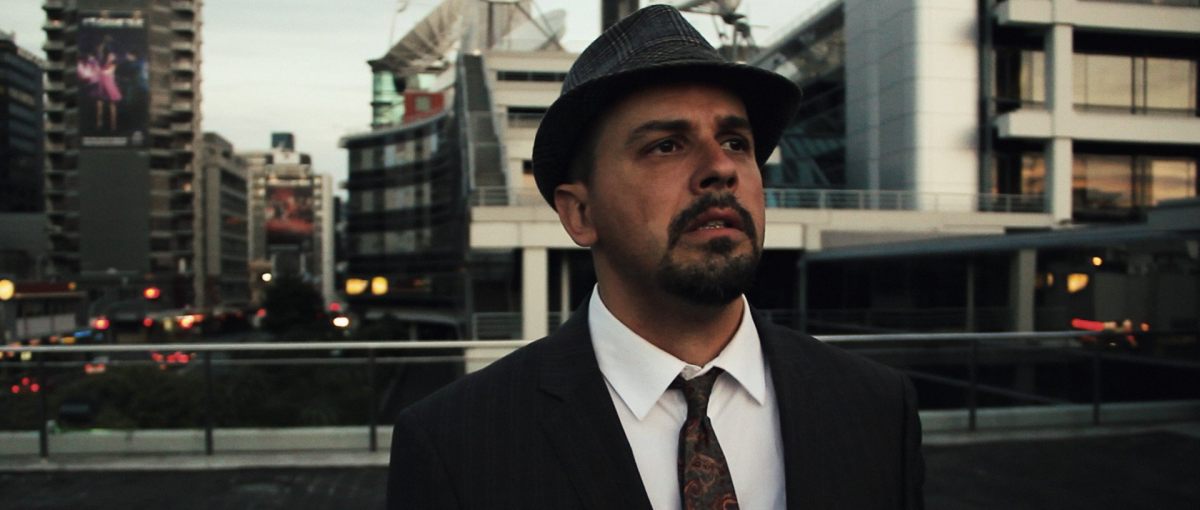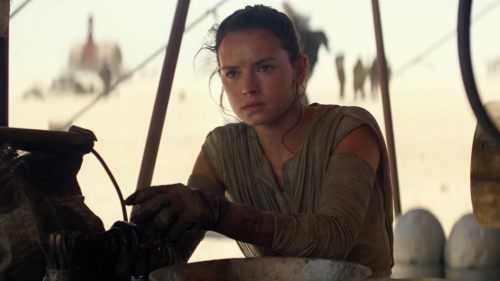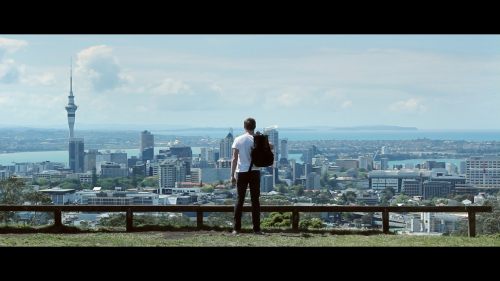Five Hard Lessons We Learned Making GHOST SHARK 2: URBAN JAWS
Making movies is hard. Really hard. So hard that to embark upon making one, you have to be a little bit naive or a little bit crazy. My creative partner Johnny Hall and I were both of those things when we set out to make our debut feature Ghost Shark 2: Urban Jaws five years ago, and though we’re still a bit crazy, the ordeal has made us marginally less naive. We learned a lot making this strange beast of a movie - about filmmaking, about each other, and about ourselves. I’m not going to try to sell you the movie*; rather, I want to impart some hard-learned wisdom.
A brief background on the project: six years ago, Johnny and I road-tripped through New Zealand to see Antichrist, and our in-car bullshitting netted the idea of Ghost Shark - a spectral shark that can swim and attack through any form of water, be it liquid, solid, or gaseous. In 2010, we shot a faux trailer for the sequel to this nonexistent movie, and after it achieved, in hindsight, an insufficiently high level of viral attention, we set out to turn that trailer into a no-budget feature. Thus, Ghost Shark 2: Urban Jaws was born. It’s been a hell of a ride from concept to release - here are five indie filmmaking lessons we learned along the way, dredged from our memories just for you.

1. Know what you’re making.
Ghost Shark 2 was written over a couple months, which ultimately and obviously was far too rushed. We hamstrung ourselves slightly by the conceptual tasks we set out to achieve. We wanted to take its ridiculous concept completely seriously. We wanted it to be a fake “in the city” sequel, in the proud tradition of Predator 2 and Babe: Pig in the City, to a movie that never existed (at the time). And most cripplingly, we forced ourselves to include as much story content from our original faux trailer as possible.
Adhering to those guidelines gave us a lot of problem-solving to do in the edit. Our structure was too sequelly, paying fake fanservice to a nonexistent movie at the expense of character focus. Our script was too talky, much of it written without considering how to visually treat it. All of that had to be remedied in post. We also failed to consider our target audience, and just how niche our movie was. As a movie about a ghost shark that’s actually a melodrama about men hiding their feelings, it’s pretty goddamned niche.
It’s also important that everyone on your production knows what they’re making, and that’s an area where we sort of did OK. Tone is chief here: one of the hardest things to nail and one of the most vital. Ghost Shark 2 leans heavily on silliness played straight, and the actors especially had to carry that on their shoulders. Before production, we did a table read to get the funny out of our systems and to make sure everyone was on the same page. And the acting had to be backed up by filmmaking that fit the same tone - within the bounds of our budget and resources.
2. Recognise your limitations.
One of the worst mistakes made in indie filmmaking is setting out to make a movie you don’t have the resources for. I see it a lot in the short filmmaking competition I help run - often from students who write stories they don’t have the means or personnel to tell. With low-budget productions, something has to scale down - the cast size, the number of locations, the length of the shoot, anything. Otherwise, something’s going to end up crappy.
Admittedly, Ghost Shark 2 was wildly ambitious beyond our abilities, a film with many characters, taking place in many locations, and with a necessary reliance on visual effects to boot. We didn’t have much money - not even crowdfunding, so eager were we to just get straight to it. But we shot the thing damn quick - half of the movie was shot over a long weekend - and did a couple of other things that made the movie suit and hopefully overcome its budgetary limitations.
Our crew was tiny, a handful of people well-versed in 48-hour filmmaking and the like. We shot mostly handheld on a DSLR, using entirely existing lighting, so we could jump between setups rapidly. For the main cast, we chose actors we trusted to nail their characters instinctively. And when we eventually figured out how to shoot our death scenes, they were designed around our inability to afford special effects. But the best thing we did for our visuals was to shoot in a variety of interesting locations. Locations are sets where the art direction is (mostly) done for you, and writing around what we could access made the film look immeasurably better.

3. Try, try again.
Watching a first edit can be incredibly depressing. It certainly was for us. After editing everything we shot into screenplay order, we had a 90-minute assembly cut that played from beginning to end, but whose pacing was awful, story confusing, tone muddled, and action scenes boring. Johnny and I screened an early cut of Ghost Shark 2 for several prominent New Zealand screen industry figures, and the response was both helpful and soul-crushing. It confirmed the worries that had been percolating in our minds over the preceding months, and put us - the entire post-production team - into a creative funk.
So disheartened were we that we took what became an eighteen-month hiatus, unsure of how to fix the film’s problems. Ghost Shark 2 was a sword over our necks, rendering us unable to work on other creative projects, taunting us with its continuing incompletion. People from all over - even Antarctica! - kept asking “when is Ghost Shark 2 coming out,” a question which turned into a maddeningly irritating meme for us. We hated the movie, we hated filmmaking, we hated each other, and most of all we hated ourselves.
What our hiatus achieved was giving us distance between ourselves and the project. The phrase “kill your darlings” is overused, but we took it to a mass-slaughter level. In any creative endeavour, it’s easy to get attached to your work - because it took a lot of effort, because it has sentimental value, or because you just, for whatever reason, like it. Accordingly, it’s a liberating feeling to let go of that attachment and see merely parts of a storytelling machine. After eighteen months of avoiding and hating Ghost Shark, we’d unwittingly developed a cold, critical eye that was crucial towards completing it. So we started a process of iteration and sweat to solve the creative problems we faced.
The subsequent changes we made were significant. Let it never be said that reshoots are a bad thing - we replaced nearly every death sequence in the movie. We cut probably half a dozen scenes - whole plotlines, even - for reasons of pacing and narrative clarity, including a scene shot in Los Angeles that featured Troll 2’s George Hardy, The Room’s Juliette Danielle, and Birdemic: Shock and Terror’s Alan Bagh. That was a fun scene, one of our most sellable elements, and a mean feat of logistics to pull off, but it just didn’t work in the movie. (Juliette has another scene in the movie, and the original sequence can be found in the special features.)

The story changed subtly, shedding some confusing narrative specifics in favour of a more broadly emotional arc centring on the character of ghost shark hunter Tom Logan. We wrote a full-length musical score that tied the film together tonally as much as it could. And we went through multiple different approaches to the shark visual effects - from a five-foot-long articulated puppet to hand-drawn animation - before settling on our final result, a trio of foot-long plastic shark toys. In the end, we went from an 88-minute first cut to a 70-minute final cut, which also featured 15 minutes of reshot scenes. The result is immeasurably better: funnier, better-paced, and in tune with our original goals.
4. Releasing a movie is as hard as making one.
Even when we finally had a movie we were happy with and could declare finished, we didn’t really know how to release it. A DVD release seemed unlikely, given our lack of financial support from essentially anyone. We had made the mistake of submitting our awful first cut to festivals, which probably soured them towards us forever, and to be honest, Ghost Shark 2 is just too niche to fit in most festivals anyway (although hey! If you run a festival or a cinema, feel free to book us. We give good Q&A).
We also had to deal with the fact that while we were in post-production, the SyFy channel made and aired their own Ghost Shark movie, sporting almost exactly the same conceit as ours. I don’t know whether they ripped us off, but even if it was coincidental parallel invention, it seems odd that they wouldn’t Google the title of their movie. At any rate, our movie suddenly looked like a sequel to a kind-of crappy and soulless TV movie. It’s a strange situation to be in, and a difficult one to handle. All I hope is that SyFy don’t sue us.
Luckily, by the time we actually finished the movie, VOD had become much more accessible. Despite much well-meaning advice telling us to go with the major VOD platforms, we somewhat stubbornly continued blazing our own path, selling our movie through VHX.tv, at least in the first instance. The online tools and customer service at VHX have both treated us superbly, enabling us to build a package that's essentially our ideal VOD release. But the market is supersaturated with indies, and it’s easy to get drowned in the mire along with everyone else. Even with a fun movie and a great web platform, getting your movie in front of eyes is super-difficult.
Marketing is something we haven’t yet cracked. It’s something we’ll have to consider harder with subsequent projects. We screened Ghost Shark 2 at a couple cinemas in New Zealand, to positive reactions and sold-out sessions, and we’re essentially relying on word-of-mouth to get the movie to spread. It’s not the best strategy, but, uh, if you watch it and like it, tell some folks.

5. Trust your collaborators - and yourself.
Filmmaking is an inherently collaborative process, and requires people skills. The James Camerons of the world are outliers: being able to collaborate smoothly is one of the best skills you can have. Shooting Ghost Shark 2, Johnny and I had a co-directing relationship where we each handled different elements of the production - but in post, we were editing as equals. Initially, we’d argue about editing decisions purely because they were our ideas, but eventually, we had to put ego aside and do what was best for the movie. Hearing criticism - and giving it constructively - is vital to the creative process, and in this nonlinear age, there’s nothing stopping you from trying multiple approaches to a problem to see which solution works best.
But trusting your creative partners means nothing if you can’t trust yourself, and I, at least, encountered a major bout of depression making Ghost Shark 2. It came at the point where the movie wasn’t finished and wasn’t looking like it was going to be finished anytime soon. I came close to deleting the whole project multiple times. I doubted myself, my abilities, and virtually every choice I’d made in my life up until that point. I couldn’t work, I certainly couldn’t work on the movie, I withdrew from the relationship I was in, and I was generally a very unhappy person. Creative work can do that - it becomes so personal to you that any setback feels like a life-altering disaster.
But I’m glad that Ghost Shark 2 pushed me into those dark places, because thanks to hitting that low point, I learned to know myself a lot better. Eventually, I realised that Ghost Shark 2 wasn’t the problem - my mind was the problem, and this was only the latest symptom. I started actually talking to people about my depression for the first time, and that helped me climb out of the hole into which I’d fallen. It was only once I’d come to terms with my own feelings that I was able to work on the movie with Johnny again, recutting it, scoring it, and mixing it (all in my lounge, which is kind of ridiculous). Ghost Shark 2 may have broken me, but it enabled me to rebuild myself better than I was before.

All the film-school education in the world couldn’t teach me the things I learned on Ghost Shark 2 making and repairing every mistake in the book. It wasn’t until we had that disastrous first version of the movie that we truly understood why the rules of filmmaking are how they are. Our process of discovery was painful and educational. I wouldn’t have my current (still incomplete) understanding of cinema - or of myself - were it not for fucking everything up and working my ass off to fix it. In gutting and reshaping the movie, the very nature of narrative structure revealed itself; cinema became a puzzle of interlocking, moving parts, all of which contributed to that elusive goal of making a movie that “works”.
Does Ghost Shark 2: Urban Jaws “work”? Not always, but often. If we were to remake the movie, there’s a lot that we’d change. That’s inevitable. But it has its own unique, amusing, and fucking weird charm, and even if it gets torn to pieces by critics or audiences, nothing can take away the lessons - for both filmmaking and life - that we learned along the way.
God damn ghost shark.
* Okay, maybe I’ll sell it a little: Ghost Shark 2: Urban Jaws is available now worldwide on VOD from www.ghostshark2.com - cheap, high quality, and DRM-free. Enjoy our strange little movie, and please, for the love of God, don’t pirate it.


